BY RICHARD SCHICKEL
Photographed by Annie Leibovitz
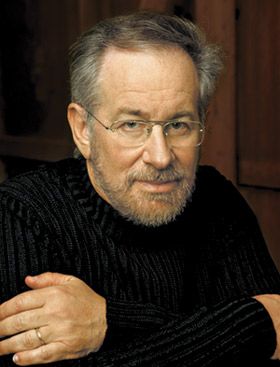 Over the past three decades I’ve conducted 19 very extensive interviews with the great American directors, ranging from Alfred Hitchcock to Martin Scorsese. All of them have been, for me, delightful experiences, none more so than the latest of them with Steven Spielberg, from which this story is excerpted.
Over the past three decades I’ve conducted 19 very extensive interviews with the great American directors, ranging from Alfred Hitchcock to Martin Scorsese. All of them have been, for me, delightful experiences, none more so than the latest of them with Steven Spielberg, from which this story is excerpted.
Steven is a wonderful subject. He’s smart, self-amused, occasionally self-deprecating—yet justifiably proud of the journey he’s made from the delicious entertainments of his youth to the kind of thoughtful questing movies that have marked his later career.
He recently turned 60, but there is about him a boyishness—even a kind of innocence—that is ineluctable. He is all enthusiasm—for his next project, for the works of his fellow directors, about which he is remarkably knowledgeable, as you will see below.
His relationship with the Directors Guild mirrors his own personal history—as a sort of coming to consciousness. He joined the DGA when he was 22, making television programs as a Universal contract director. That’s when he became hooked on the DGA screenings of new films. “They didn’t have popcorn or Dots or soft drinks,” he remembers, “but they did have the best projection and sound in town.” Later, as he met more colleagues, the Guild became for him, “a sort of postgraduate USC experience for a young man who was," as he admits, “only a USC wannabe.” It was in that period, as his own films became more challenging and aspiring, that he “grew into a knowledge of Guild history,” and began to see that “in foul weather” the Guild “surrounded you with friends.” He is a member of the Western Directors Council, and, as the DGA celebrates its 70th anniversary, he hopes to become even more involved. The Guild, he says, is “protecting our backs while developing a vision of our future.”
RICHARD SCHICKEL: There’s a popular myth that you got started in the film business when you snuck on to the Universal lot. Is that true?
STEVEN SPIELBERG:
No, that was before they hired me. I was in high school in Arizona and visiting some cousins and I took a tour one day—you know, they had the old Gray Line Tours—and they gave everybody a bathroom break about midday. So I got off to go to the bathroom and I hid in the stall, and I waited until everybody had left. I came out a half an hour later and I was free. I was on the Universal Studios lot.
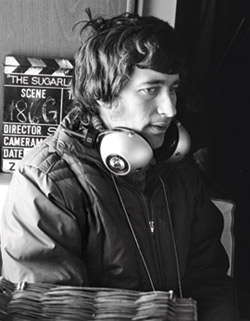 NOT SWEET: The Sugarland Express (1974), Spielberg's
NOT SWEET: The Sugarland Express (1974), Spielberg's
first feature, introduced his theme of the
isolated child. (© AMPAS)
Q: No one stopped you?
A:
Nobody stopped me. I met the film librarian, a man named Chuck Silvers, and he thought I had a lot of chutzpa and showed ambition, so he gave me a three-day pass on his own name. So I did that for three days, and then I took a shot that maybe the guard would recognize me without having to show him my papers. And so on the fourth day I walked onto the lot and waved at Scotty, the guard. Scotty waved back and I spent the next two and a half months on the lot five days a week until school began and I had to go back to Phoenix.
Q: Did you know at that time you wanted to be a director?
A:
I didn’t. I never had a big thought about what I could do with movies in those days. I was infatuated with the control that movies gave me in creating a sequence of events or a feeling, stuff like a train wreck with two Lionel trains that I could then repeat and see over and over again. I think it was just a realization that I could change the way I perceived life through another medium to make it come out better for me. I was making these little 8mm rinky-dink movies and I knew that made me feel really good about my life, and possibly I could bring some other people into this amazing medium, to enjoy what I was putting together.
Q: Then, based on a short film you had made, you came back to Universal to direct episodic TV. How much more exponentially did that increase your skills?
A:
Sid Sheinberg offered me a seven-year contract to direct television. I felt like I had come home. The fact that I was doing TV was going to be a postgraduate program on the way to making feature films; that’s how I regarded television. It was a learning process. I had never directed anything professionally. [Growing up] the crew on my films numbered nine or ten kids my own age. Now, I was doing my first television show [Night Gallery], starring Joan Crawford, no less. And the crew numbered well over 75, and the average age was 50. And when I showed up with my acne and my long hair and the viewfinder pretentiously around my neck, like some kind of a talisman that would protect me from all evil, I think they took one look at me and they said, this kid better prove himself quickly or he’s out of here. The rank and file of the crew was just sending daggers my way, working as slowly as they could—not to get themselves fired, but maybe to get me pushed off the show. It was a real baptism by fire.
Q: So what was the lesson you took away from this trauma?
A:
I learned immediately that I needed to get final cut someday because a director in television loses control the second that he walks off the sound stage and postproduction begins and editorial takes over. Then the producers get very involved and kind of over-cut you or re-cut you or second-guess the cutting of the film. And I realized that my goal was at some point in my life to have control over the movies I made.
Q: Only two years later you made your first movie, Duel. It seems a sophisticated piece of filmmaking, given your age. How did you get that assignment?
A:
I lobbied for it very, very hard. I had just finished directing Colombo, the very first show of the series, and it turned out really well. So I showed George Eckstein, who was producing Duel, my rough cut and he liked it and then represented me to the network, and I believe he went to Barry Diller, who was then head of ABC, and Barry approved me. And so I got this amazing gig.
 |
Jaws (1975) (© AMPAS) |
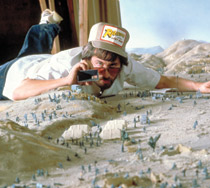 |
Raiders of the Lost Ark (1981)
(© Courtesy Spielberg) |
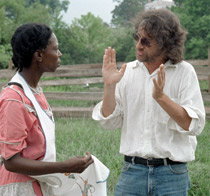 |
The Color Purple (1985)
(© David James/Universal) |
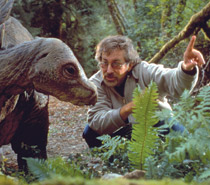 |
Jurassic Park (1993) (© Paramount) |
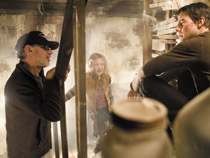 |
War of the Worlds (2005) (© Paramount) |
Q: Were you nervous? What kind of prep did you do?
A:
I had done about seven or eight episodes of different series, so it was like, ‘Please, I hope this experience serves me well,’ because I had only 11 days to shoot a 74-minute TV movie. I went out into the desert and I didn’t storyboard, but I had the art department actually draw a map of the story, where all the set pieces were to take place. And I put little inverted V’s all over this map to help myself realize where I was going to put the A, B, C, D and E cameras, because I had five cameras on some of these truck and car chases. So within one mile of highway, I could get a whole lot of shots, at least five angles, then turn the vehicles around, simply turn the cameras around, change lenses and have them go the other way, and be able to use that footage, going not only from right to left, but from left to right.
Q: The script was also very effective.
A:
I get a lot of credit for figuring out how to make Duel a very suspenseful, Hitchcockian story, but Richard Matheson’s script was already Hitchcockian and suspenseful. I think that was the first time I realized, ‘Hey, if I have a good script, and I’m a good director, I can make a pretty terrific movie.’ I think that was the first time I really embraced the idea that directors need great screenplays to look good.
Q: Your first feature, The Sugarland Express, has the theme of the isolated child that became familiar in your work. Were you aware of that yet?
A:
I’m really not sure how conscious I was of that when I was making The Sugarland Express. I wrote the story based on this newspaper article I read about an actual couple that was going to get their baby back from child welfare and this led to a crazy, hullabaloo of a chase throughout Texas. It did not escape me that Billy Wilder had made one of my favorite movies of all time, which was Ace in the Hole, and that really affected me and the whole carnival atmosphere of an ongoing tragic situation and the capitalization and sensationalizing and exploitation of that.
Q: Jaws was such a big movie in your career, but you had a lot of difficulties making it. Do you have good memories of that period?
A:
I credit Jaws with everything, being a movie director, having final cut. Jaws gave me freedom, and I’ve never lost my freedom. But the experience of making Jaws was horrendous for me. And it was partially because the script was unfinished and we were all making it up as we went along, not unlike the whole experience with Casablanca.
Q: The common wisdom is ‘don’t shoot on water.’ Bob Wise once told me that making The Sand Pebbles almost drove him crazy.
A:
Yeah, everybody told me not to shoot on water. I mean, everybody. Sid Sheinberg even said, ‘Why don’t you build a tank on the back lot? We’ll pay for it.’ And I said, no, I want to go out and I want to battle the elements, I want people to think this is really happening, that the shark is really in the ocean. I don’t want this to look like The Old Man and the Sea, with the obvious painted background and all of that.
Q: Jaws was like a prehistoric character, the shark being an attack out of prehistoric times. Is that the idea that attracted you to Jurassic Park?
A:
I really believe that when I read Michael Crichton’s book, I flashed back to Jaws and I flashed back to Duel. Look, I’d wanted to make a dinosaur picture all my life because I was a huge fan of Ray Harryhausen.
Q: Jurassic Park was the primary CGI film. Were you aware of what was looming in that world of CGI?
A:
The very first CGI ever used in a commercial movie was in a film that I produced and Barry Levinson directed, called Young Sherlock Holmes. ILM had generated a stained glass window of a knight that comes to life, jumps out of the stained glass window and threatens our cast. That was maybe the first commercial use ever of a digital effect. Of course, the second effective use was when Jim Cameron made The Abyss and he had the water tendril and that was an extraordinary digital effect. But a digital dinosaur, a main character, had never been done before for the movies. So, in a way, Jurassic Park was the first movie where the entire success or failure of the story was dependent on these digital characters.
Q: Indiana Jones is an archeologist, another character whose business it is to study the past. How developed was the story when you and George Lucas were sitting on the beach in Hawaii talking about this?
A:
Well, I came to Hawaii to sort of hold George’s hand the day Star Wars opened in 1977. When the phone rang and he found out that every single 10:30 a.m. show throughout the entire nation had been sold out, George became euphoric, to say the least, and, in his euphoria, immediately began thinking about the future. And he asked me what I was doing next. I said I wasn’t sure, but I wanted to try again to get Cubby Broccoli to let me direct one of the James Bond films. Cubby, by the way, had twice turned me down when I asked if I could direct a James Bond film. And George said I’ve got something better than James Bond, it’s called Raiders of the Lost Ark.
Q: After Jaws and Close Encounters, both enormously successful movies, you made 1941, what went wrong with that?
A:
I wanted to make a really, really funny movie, I had never done a comedy before. And I haven’t really made one since either [laughs]. But I wanted to try this. It was a big demolition derby. I have to tell you, when I made 1941, I felt like I was made of Teflon. I felt that anything I put on film was going to succeed; that every laugh I set up would receive not only a laugh, but huge applause; that everybody was going to win an Academy Award. It was my longest shooting schedule, and I actually went over schedule further on 1941 than I had on Jaws. I sobered up so quickly after that was over. And I look back, and it’s not that I misbehaved, I didn’t, but I just became so precious and indulgent about getting everything right. I did 20 takes on inserts that should have been done by a second unit. I couldn’t let go. I couldn’t share the workload with anyone. And I learned the greatest lesson of my career, just from the experience of 1941, and by the time I did Raiders of the Lost Ark, my next picture, I was humbled. Every single shot was storyboarded. I was 14 days under schedule.
Q: Later on, Empire of the Sun was a totally different take on World War II. How did you come to do that film?
A:
I had become friends with David Lean, and David called me and said, ‘There’s a book I fancy directing called Empire of the Sun by J. G. Ballard. I understand that the rights might be tied up at Warner Bros. Could you investigate it for me?’ And I did. I called Terry Semel, the head of Warner Bros., and Terry confirmed that there was a director attached to it, and Tom Stoppard was working on the screenplay. So I called David back and told him that it was indeed spoken for. And then six, seven months later, Semel called me and said, the elements have changed. And I called David back, and, in the time that had passed, he had changed his mind. And he said, ‘You should do it. I think this is right up your alley.’
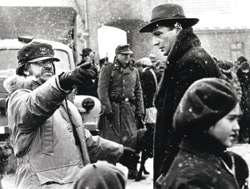 |
Schindler's List (1993) (© Universal City Studios) |
Q: Schindler’s List seems like the most difficult film you ever did, even just technically. Did you resist the movie when it was presented to you?
A:
Sid Sheinberg found it. He said, ‘I think you need to tell the story.’ So he bought the book for me. But, frankly, I didn’t think I was ready to tackle the Holocaust in 1982 and I actually had more films to make and more steppingstones. I couldn’t have gone from Indiana Jones and the Temple of Doom to Schindler’s List. That would have been impossible. I didn’t have the maturity, both the craft and emotional information to be able to acquit the Holocaust in an honorable way. So I kept trying to give it away to people who kept giving it back to me.
Q: One of the most talked about moments in the film was when Schindler looks down and sees the girl in the red coat. Was that pure fiction?
A:
No, it’s true. Oscar Schindler witnessed, with his girlfriend, the liquidation of the Krakow Ghetto that morning. He was horseback riding. He heard all the noise. He heard all the vehicles moving in through the Ghetto. We actually shot the entire sequence on the same spot where Schindler was sitting atop his horse, and what the audience sees is exactly what he saw looking down from his point of view 56 or so years ago from the time we shot the sequence.
Q: At the time, a lot was made of the fact that you made the coat red in a black-and- white movie. What was your thinking behind that?
A:
The Holocaust was known about in very small secret circles, but certainly Roosevelt and Eisenhower knew. Nothing was being done to slow down the industrialized progress the Nazis were making in the total annihilation of European Jewry. The Allies did nothing except they were pursuing the war effort. So that was my message in letting that scene be in color. It was as obvious as a little girl wearing a red coat walking down the street.
Q: Let’s turn to Saving Private Ryan. Although it’s a tragic story also, it’s a much more open picture than Schindler’s List. How did that project come about?
A:
I was looking for a World War II story to direct. I read many books, many screenplays, many short stories, and then Robert Rodat’s screenplay for Saving Private Ryan was sent to me by my agency. As a matter of fact, it was the only time in my several decades of having an agent that they actually gave me a screenplay that I wound up directing. (Laughs)
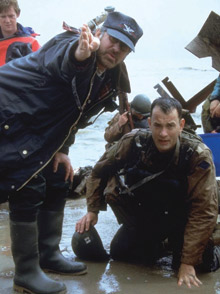 |
Saving Private Ryan (© Amblin Entertainment) |
Q: At the beginning of the movie, you start with this incredible D-Day sequence. Had you planned out the whole thing?
A:
I didn’t quite know what that opening sequence was going to be because I shot the whole movie in continuity, and I certainly shot the whole first sequence in continuity. The first shot of the movie is Tom Hanks’ hand shaking, and I went right through to the end of the picture in continuity, which meant that I was making up the entire opening attack of the landings at Omaha Beach. I did the whole thing stream of consciousness. I had no storyboards, no pre-visualization on the computer, did the whole thing from actually up here [points to his head], in a weird way being informed by all the literature I had read about the up-close-and-personal experience of what it was like to survive that day on Omaha Beach. I didn’t know it was going to take four weeks to shoot 26 minutes of movie. When people would come over to me and say, ‘Are we going to be done next week?’ I’d say, ‘I don’t know.’ Because the whole thing was being improvised, in a very safe, rational, controlled way, but improvised nonetheless, and I think if anything gave that scene its impact, its first person, in-your-face impact, it was because I didn’t know what was going to happen next, just like real combat.
Q: There was some criticism of Private Ryan as being ‘too Hollywood.’ What was your response to that?
A:
I’ve always wanted to make a war movie, and I had a chance to make a realistic war movie, as opposed to an apocryphal Hollywood war movie. Actually, I was beating away the impulses to go Hollywood. People who found fault with Private Ryan always picked on it because I had a guy from Brooklyn, I had a Jewish guy, and they said, ‘Oh, you’re using the same mix that Lewis Milestone used in A Walk in the Sun. You’re mixing ethnicities and cultures and showing that Americans are from all over the world.’ That doesn’t bother me at all because you can’t have seen as many World War II movies as I’ve seen, and not have some of that rub off on Saving Private Ryan.
Q: One of the things that give your films their power is John Williams’ score. Can you talk about that?
A:
John Williams has made the most remarkable contribution to all of my movies. With the exception of one film, he’s scored every film I’ve ever directed. He’s made contributions that you can’t quantify because they reach the heart before they ever go anywhere near the brain. With E.T., especially, at the end, ILM and I can make those bicycles lift off and get off the ground, but John Williams is the only one who can make them truly airborne, because the audience lifts off the ground on his violins. And the audience is carried across the moon or the sun with his string section and his horns later on when they land. I think the last 15 minutes of E.T. is as close to an opera, because of John Williams’ contributions, as anything I’ve ever done before in my life.
Q: You’ve said you couldn’t have made Schindler’s List or Private Ryan if you hadn’t had the experience of The Color Purple. What did you mean by that?
A:
I think of all my movies, The Color Purple was my first grown-up film. It was the first movie that doesn’t go better with popcorn. The audience has to find their own space and experience and empathize with those characters. The story was told through the words and experiences of these characters, not through the bigger concept of a shark attacking a summer resort or a truck going after a car. I had a tone in my mind about The Color Purple, and there were going to be moments of sheer horror between characters, but set in a beautiful tapestry of purple flowers and beautiful farmland and growing corn, just the beauty of a la John Ford, and an unbearably heartbreaking story inside this bucolic picture frame.
Q: I know you considered shooting it in black and white.
A:
My first instinct was to shoot the film in black and white, and when I gave Whoopi Goldberg her first screen test, I shot her in New York that way with Gordon Willis, the great cinematographer of The Godfather. I was flirting with telling the story in black and white because I was afraid of myself. I was afraid that I was going to sugarcoat the book and if I at least shot it in black and white, there would be no sugar to coat anything with. And maybe the first time I chickened out was the decision to make the film look beautiful. Allen Davieu, who ultimately shot the film, and I decided to make this look beautiful—faces, interiors, exteriors—and I think that beauty might have overwhelmed people’s memory of the violent poetry of Alice Walker’s book.
Q: Your last film about communication between people was The Terminal, perhaps your starkest example of alienation, but it was also a wonderful little fantasy.
A:
I thought of two directors when I made Terminal. I thought this was a tribute to Frank Capra and his honest sentiment, and it was a tribute to Jacques Tati and the way he allowed his scenes to go on and on and on. The character he played in Mr. Hulot’s Holiday and Mon Oncle was all about resourcefulness and using what’s around him to make us laugh.
Q: Munich strikes me as different from all your other films. I don’t see any lost child or the themes normally in your films. Is it more on your futuristic level but with terrorists?
A:
I never imagined Munich as an aberration from all the films I’ve made. I kind of saw it as a story that I felt needed to be told. I just saw it as a film whose time had come. It satisfied a need in me to discuss something that was important to me as someone who supports Israel, and also as someone who supports the process of achieving a lasting peace in that region through honest, non-violent discourse.
Q: Did you anticipate the controversy that film would stir up?
A:
Well, I knew Munich was the most intentionally political film I’ve ever made. When we were making the film, Tony Kushner and I would sit around waiting for the shot to be lit and talk about how people were going to have a real tough time understanding and reconciling what this film is. And Tony was the one, more than even me, who said, ‘We’re going to make a lot of noise with this movie, and it’s not all going to be good.’ And I would say, ‘Is any of it going to be good?’ And he said, ‘Maybe 10 years from now, but I think when this film comes out it’s going to be swift-boated.’
Q: The other thing that’s fascinating about this movie is that, setting all politics aside, it really functions as an absolutely first-class thriller.
A:
I was thinking about Munich not just politically, but I had Fred Zinneman on my mind with Day of the Jackal, and I had Costa-Gavras on my mind with Z. And also Pontecorvo’s The Battle of Algiers. I had the thriller aspect of these movies banging around inside my brain while I was making Munich.
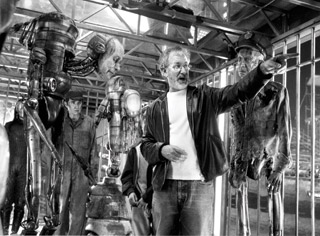 |
FUTURE SHOCK: Even the androids pay attention when
Spielberg directs on A.I. (2001). (© AMPAS) |
Q: I’m sure you get asked this a lot, in A.I., what’s yours and what’s Kubrick’s?
A:
People assume the exact opposite of what the truth is. People assume that Stanley ended A.I. with David and Teddy underwater, trapped by the Ferris wheel, and that they’re going to be down there until their batteries run out. And I, of course, get criticized for carrying the film 2,000 years into the future, and they assume that that’s how I wrecked Stanley’s movie, when in fact every single beat that I put in my version was first in Stanley’s 95-page treatment. The whole superstructure of A.I. is Stanley Kubrick’s vision, and I got as close to his vision as was humanely possible.
Q: Did you ever discuss this with him?
A:
We’d talk hours on the telephone. One day we talked eight hours, with a break for lunch. Stanley used to say in the ’80s, ‘You should make this, not me, this is more your sensibility than mine.’ He told me that a dozen times. The only thing Stanley ever really actively involved me in of any of his projects was A.I. For the first time he said, ‘I want you to read a treatment that I’ve written.’ He had never sent me treatments for Full Metal Jacket or anything he had done before that in all the years I knew him.
Q: Minority Report, a post-9/11 movie parable of a super security state, raises questions about free will. What appealed to you about this story?
A:
I always wanted to do a George Orwell-style story because I had loved 1984 when I was young, and then when Minority Report came along, which was a screenplay by John Cohen and then Scott Frank, we worked on the script for a long time. It was also going to be a throwback to a Humphrey Bogart/Lauren Bacall film noir detective story. So aside from all of the political parallels, it’s also stylistically, cinematically informed by To Have or Have Not and The Maltese Falcon, so it was a hybrid movie for me, about my love of film noir and, at the same time, my love of good, old-fashioned murder mystery yarns.
Q: Technically, the film does have a noir look.
A:
Well, what happened was [cinematographer] Janusz Kaminski did a very heavy E and R process on the film. The film has a very blue wash to the whole thing. We shot it on Super 35, which means that for your release prints you have to blow it up a little bit, which increases the grain and makes it a little more textural, so you can almost feel the images. And that was all something that Janusz brought to the look of the picture.
Q: Let’s talk about your last two pictures. War of the Worlds had been told before, most sensationally by Orson Welles on radio, and George Pal on film. Was there something new or different you were trying to add?
A:
I was always wanting to make War of the Worlds, but when Roland Emmerich came along with Independence Day, he kind of took all the steam out of [my plans] and I needed to find another angle to tell the story of a Martian invasion without the Martians. The way David Koepp and I and Tom Cruise envisioned doing that was through the point of view of a kind of deadbeat father who’s not very good with his kids, and has to become in a couple of days the greatest dad of his life in order to save their lives. I thought that brought the audience into the film more than it would have, had it been told through the point of view of the joint chiefs of staff or the vice president of the United States or field commander.
Q: Your last few films have been pretty grim, do you think your future films will continue in this same dark vein?
A:
I’m not consciously planning anything. I don’t say, okay, now I just have to make light popcorn movies to give people relief from the subconscious demons that have pushed me into more historical, darker subjects. I do whatever comes along when I think its time has come. When it’s the time for Lincoln, I’ll make Lincoln. When it’s the time for Indiana Jones, Part Four, I’ll make that film. I’m just saying that when a film’s time has come, I know it. And I know when it isn’t right for me to direct, but maybe it’s okay for me to co-produce and to mentor a director, something like Memoirs of a Geisha. I intuitively know those things, and I think my intuition has been about 75 percent right on and 25 percent not right on. So I’m just going with the odds.
Q: Is there a particular lesson you’ve learned about storytelling?
A:
I think there’s a little moment of mystery that occurs in a movie where two people don’t quite understand each other, and then suddenly understand what they mean to each other and what their lives are all about. The audience has these epiphanies that often go unheralded, but it gives them a chance to say, ‘I’m part of this story. Thank you, you’ve included me in your story.’ It invites the audience into the process. Film is a visual language, and then there’s the great art of the spoken word. And my job is to put the audience inside the movie. My job is to reduce the aesthetic distance between the audience and the experience, so they are lost for two hours and they only wake up when they walk out of the theater and the sunlight hits them in the face. I think all of us are either successes or failures based on how far inside the experience of the story we can put the audience.